标签:extend ted 大量 不兼容 abstract action 结构型模式 on() normal
代理模式:由于某些原因需要给某对象提供一个代理以控制对该对象的访问。这时,访问对象不适合或者不能直接引用目标对象,代理对象作为访问对象和目标对象之间的中介。
代理模式的主要角色如下。
结构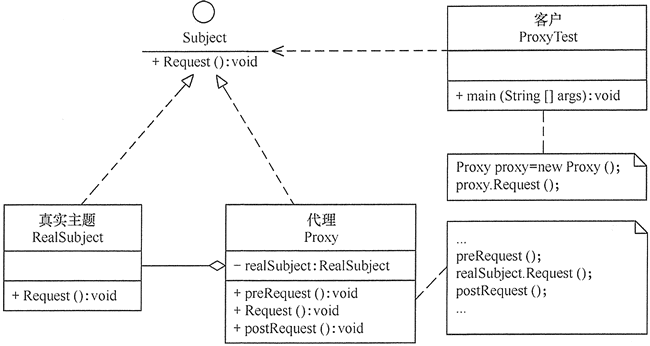
public class ProxyTest { public static void main(String[] args) { Proxy proxy = new Proxy(); proxy.Request(); } } //抽象主题 interface Subject { void Request(); } //真实主题 class RealSubject implements Subject { public void Request() { System.out.println("访问真实主题方法..."); } } //代理 class Proxy implements Subject { private RealSubject realSubject; public void Request() { if (realSubject == null) { realSubject = new RealSubject(); } preRequest(); realSubject.Request(); postRequest(); } public void preRequest() { System.out.println("访问真实主题之前的预处理。"); } public void postRequest() { System.out.println("访问真实主题之后的后续处理。"); } }
适配器模式(Adapter):将一个类的接口转换成客户希望的另外一个接口,使得原本由于接口不兼容而不能一起工作的那些类能一起工作。适配器模式分为类结构型模式和对象结构型模式两种,前者类之间的耦合度比后者高,且要求程序员了解现有组件库中的相关组件的内部结构,所以应用相对较少些。
适配器模式(Adapter)包含以下主要角色。
类适配器模式的结构图:
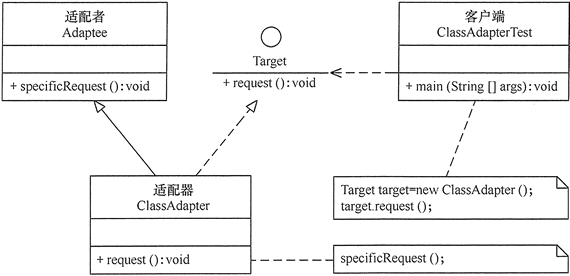
对象适配器模式的结构图:
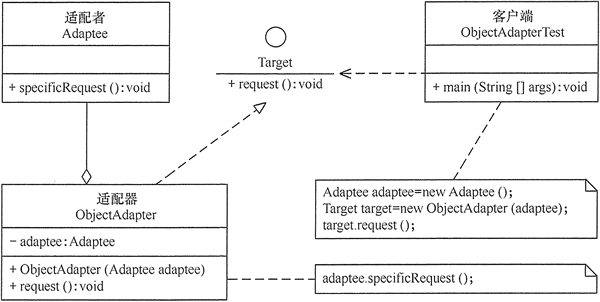
类适配器模式的代码:
//目标接口 interface Target { public void request(); } //适配者接口 class Adaptee { public void specificRequest() { System.out.println("适配者中的业务代码被调用!"); } } //类适配器类 class ClassAdapter extends Adaptee implements Target { public void request() { specificRequest(); } } //客户端代码 public class ClassAdapterTest { public static void main(String[] args) { System.out.println("类适配器模式测试:"); Target target = new ClassAdapter(); target.request(); } }
对象适配器模式的代码:
//对象适配器类 class ObjectAdapter implements Target { private Adaptee adaptee; public ObjectAdapter(Adaptee adaptee) { this.adaptee=adaptee; } public void request() { adaptee.specificRequest(); } } //客户端代码 public class ObjectAdapterTest { public static void main(String[] args) { System.out.println("对象适配器模式测试:"); Adaptee adaptee = new Adaptee(); Target target = new ObjectAdapter(adaptee); target.request(); } }
双向适配器类既可以把适配者接口转换成目标接口,也可以把目标接口转换成适配者接口
结构图:

代码:
//目标接口 interface TwoWayTarget { public void request(); } //适配者接口 interface TwoWayAdaptee { public void specificRequest(); } //目标实现 class TargetRealize implements TwoWayTarget { public void request() { System.out.println("目标代码被调用!"); } } //适配者实现 class AdapteeRealize implements TwoWayAdaptee { public void specificRequest() { System.out.println("适配者代码被调用!"); } } //双向适配器 class TwoWayAdapter implements TwoWayTarget,TwoWayAdaptee { private TwoWayTarget target; private TwoWayAdaptee adaptee; public TwoWayAdapter(TwoWayTarget target) { this.target=target; } public TwoWayAdapter(TwoWayAdaptee adaptee) { this.adaptee=adaptee; } public void request() { adaptee.specificRequest(); } public void specificRequest() { target.request(); } } //客户端代码 public class TwoWayAdapterTest { public static void main(String[] args) { System.out.println("目标通过双向适配器访问适配者:"); TwoWayAdaptee adaptee=new AdapteeRealize(); TwoWayTarget target=new TwoWayAdapter(adaptee); target.request(); System.out.println("-------------------"); System.out.println("适配者通过双向适配器访问目标:"); target=new TargetRealize(); adaptee=new TwoWayAdapter(target); adaptee.specificRequest(); } }
桥接(Bridge)模式的定义如下:将抽象与实现分离,使它们可以独立变化。它是用组合关系代替继承关系来实现,从而降低了抽象和实现这两个可变维度的耦合度。
桥接(Bridge)模式包含以下主要角色。
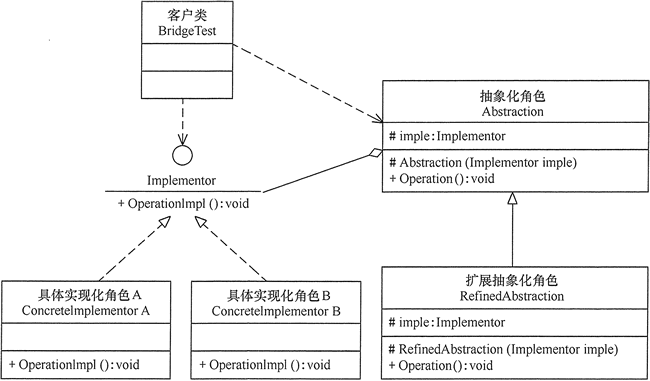
public class BridgeTest { public static void main(String[] args) { Implementor imple = new ConcreteImplementorA(); Abstraction abs = new RefinedAbstraction(imple); abs.Operation(); } } //实现化角色 interface Implementor { public void OperationImpl(); } //具体实现化角色 class ConcreteImplementorA implements Implementor { public void OperationImpl() { System.out.println("具体实现化(Concrete Implementor)角色被访问"); } } //抽象化角色 abstract class Abstraction { protected Implementor imple; protected Abstraction(Implementor imple) { this.imple = imple; } public abstract void Operation(); } //扩展抽象化角色 class RefinedAbstraction extends Abstraction { protected RefinedAbstraction(Implementor imple) { super(imple); } public void Operation() { System.out.println("扩展抽象化(Refined Abstraction)角色被访问"); imple.OperationImpl(); } }
当一个类内部具备两种或多种变化维度时,使用桥接模式可以解耦这些变化的维度,使高层代码架构稳定。
桥接模式通常适用于以下场景。
扩展:当桥接(Bridge)模式的实现化角色的接口与现有类的接口不一致时,可以在二者中间定义一个适配器将二者连接起来。
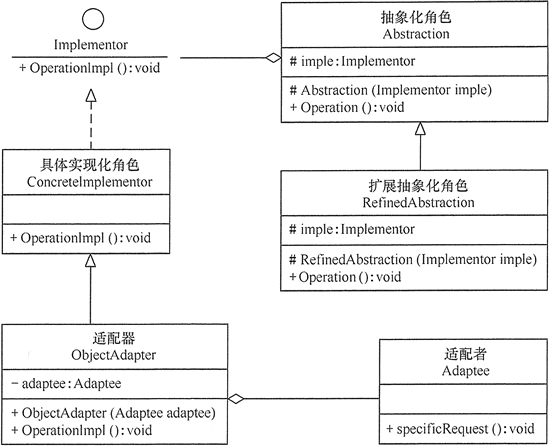
装饰器(Decorator)模式的定义:指在不改变现有对象结构的情况下,动态地给该对象增加一些职责(即增加其额外功能)的模式,它属于对象结构型模式。
装饰器模式主要包含以下角色。
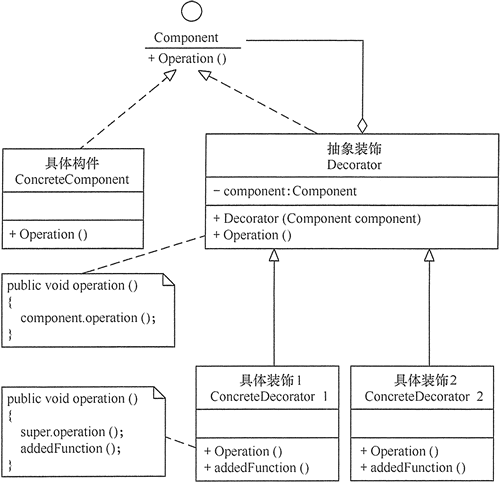
实现:
public class DecoratorPattern { public static void main(String[] args) { Component p = new ConcreteComponent(); p.operation(); System.out.println("---------------------------------"); Component d = new ConcreteDecorator(p); d.operation(); } } //抽象构件角色 interface Component { public void operation(); } //具体构件角色 class ConcreteComponent implements Component { public ConcreteComponent() { System.out.println("创建具体构件角色"); } public void operation() { System.out.println("调用具体构件角色的方法operation()"); } } //抽象装饰角色 class Decorator implements Component { private Component component; public Decorator(Component component) { this.component = component; } public void operation() { component.operation(); } } //具体装饰角色 class ConcreteDecorator extends Decorator { public ConcreteDecorator(Component component) { super(component); } public void operation() { super.operation(); addedFunction(); } public void addedFunction() { System.out.println("为具体构件角色增加额外的功能addedFunction()"); } }
前面讲解了关于装饰器模式的结构与特点,下面介绍其适用的应用场景,装饰器模式通常在以下几种情况使用。
装饰器模式在 Java
语言中的最著名的应用莫过于 Java I/O 标准库的设计了。例如,InputStream 的子类
FilterInputStream,OutputStream 的子类 FilterOutputStream,Reader 的子类
BufferedReader 以及 FilterReader,还有 Writer 的子类 BufferedWriter、FilterWriter
以及 PrintWriter 等,它们都是抽象装饰类。
下面代码是为 FileReader 增加缓冲区而采用的装饰类 BufferedReader 的例子:
BufferedReader in = new BufferedReader(new FileReader("filename.txt"));
String s = in.readLine();
标签:extend ted 大量 不兼容 abstract action 结构型模式 on() normal
原文地址:https://www.cnblogs.com/holycai/p/14720084.html